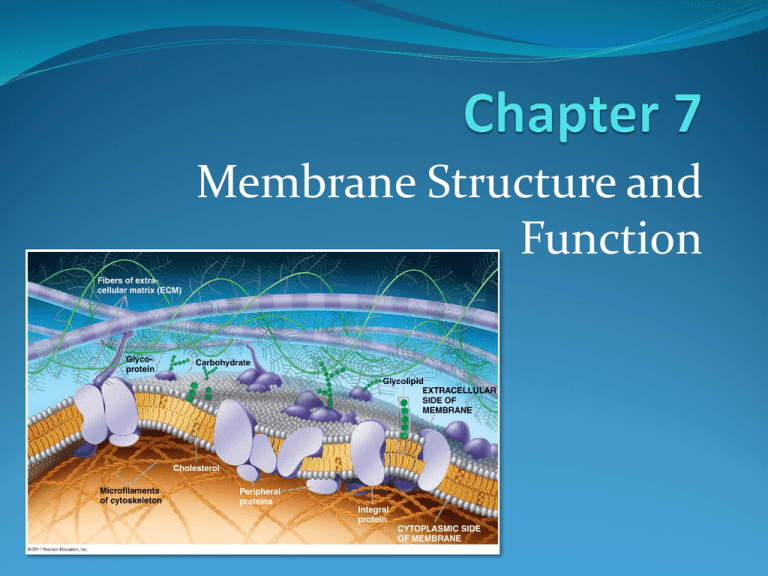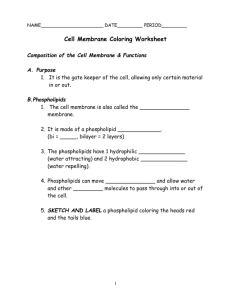
Membrane Structure and
Function
What You Must Know:
• Why membranes are selectively permeable.
• The role of phospholipids, proteins, and
carbohydrates in membranes.
• How water will move if a cell is placed in an
isotonic, hypertonic, or hypotonic solution.
• How electrochemical gradients are formed.
7-3 Cell Boundaries
Cell Walls
What is the main function of the cell wall?
Slide
3 of 47
Copyright Pearson Prentice Hall
End Show
7-3 Cell Boundaries
Many cells produce a strong supporting layer around
the membrane known as a cell wall.
Cell walls are found in plants (cellulose), algae,
fungi (chitin), some protists and many prokaryotes
(peptidoglycan).
Slide
4 of 47
Copyright Pearson Prentice Hall
End Show
7-3 Cell Boundaries
• Cell walls have openings or pores to
allow water, oxygen, carbon dioxide and
other materials to pass through. They lie
outside the cell membrane. They give
structure and support – the thicker the
cell wall the more stiff or rigid the
structure will be.
Slide
5 of 47
Copyright Pearson Prentice Hall
End Show
7-3 Cell Boundaries
Cell Membrane
Cell Membrane
What is the main function of the cell
membrane?
Slide
6 of 47
Copyright Pearson Prentice Hall
End Show
All cells are surrounded by a thin,
flexible barrier known as the
cell membrane.
Functions:
a.Controls what enters and exits the cell to
maintain an internal balance called
homeostasis
b. Provides protection and support for the cell
c. Recognizes foreign material
d. Communicates with other cells
• Teach your partner!!
• What does selectively permeable
mean?
Copyright Pearson Prentice Hall
Cell Membrane
Plasma membrane is selectively permeable
– Allows some substances to cross more easily
than others
Small molecules (polar or nonpolar) cross easily
(hydrocarbons, hydrophobic molecules, CO2, O2)
Hydrophobic core prevents passage of ions, large
polar molecules
A.Fluid Mosaic Model
– Fluid: membrane held together by weak
interactions
– Mosaic: phospholipids, proteins, carbs
Structure of cell membrane
Lipid Bilayer -2 layers of
phospholipids
– Phosphate head is polar
(water loving) “Hydrophilic” Phospholipid
– Fatty acid tails non-polar
Bilayer
(water fearing)
Hydrophobic”
– Proteins embedded
in membrane
Phospholipids
• Bilayer
• Amphipathic =
hydrophilic head,
hydrophobic tail
• Hydrophobic
barrier: keeps
hydrophilic
molecules out
Polar heads Fluid Mosaic
love water
Model of the
& dissolve. cell membrane
Non-polar
tails hide
from water.
Carbohydrate cell
markers
Proteins
Membrane
movement
animation
Membrane fluidity
• Low temps: phospholipids
w/unsaturated tails (kinks
prevent close packing)
• Cholesterol resists changes by:
– limit fluidity at high temps
– hinder close packing at low
temps
• Adaptations: bacteria in hot
springs (unusual lipids); winter
wheat ( unsaturated
phospholipids)
Membrane Proteins
Integral Proteins
Peripheral Proteins
• Embedded in membrane
• Extracellular or
cytoplasmic sides of
membrane
• NOT embedded
• Held in place by the
cytoskeleton or ECM
• Provides stronger
framework
• Transmembrane with
hydrophilic heads/tails
and hydrophobic middles
Transmembrane protein structure
Hydrophobic
interior
Hydrophilic
ends
Proteins
Cell-surface markers:
(Carbohydrates attached to the
proteins act like chemical
identification cards) Identify the cell
type and help cells work together.
Receptor proteins: Monitor
environment
Enzymes: speeds up rate of
chemical reactions in cell.
Transport Proteins: (Some proteins
form channels and pumps) move
materials across bilayer
Some
functions of
membrane
proteins
Carbohydrates
• Function: cell-cell recognition; developing
organisms
• Glycolipids, glycoproteins
• Eg. blood transfusions are type-specific
Synthesis and sidedness of
membranes
Structure of the Cell Membrane
Outside of cell
Proteins
Lipid
Bilayer
Transport
Protein
Animations
of membrane
Go to structure
Section:
Carbohydrate
chains
Phospholipids
Inside of cell
(cytoplasm)
Integral & Peripheral proteins
Facilitated Diffusion:
diffusion of hydrophilic substances is
facilitated by a protein
The cell membrane is much more than a passive barrier of the cell.
(A)Describe in detail the fluid mosaic model of the cell membrane. (6 pt
maximum)
__phospholipid description (polar head, nonpolar tails)
__phospholipid bilayer (must explain significance with reference to
polarity)
__cholesterol: effects membrane fluidity
__transmembrane proteins span the entire membrane
__role of a transmembrane protein (carrier, receptor, etc.)
__peripheral protein
__role of a peripheral protein (anchor, enzyme, etc.)
__glycolipid OR cell surface marker
__role of glycolipid (identify cell as “self” to the immune system, etc)
On a sheet of paper you will need to draw a linear section of cell membrane
(you will want a long section of cell membrane and the ability to add on
additional structures later).
For Tuesday 11/03/15 you must include: the phospholipid bilayer (show and
label the hydrophilic/polar heads and hydrophobic/nonpolar tails)
•label which side is extracellular and which side is intracellular
•at least one cholesterol molecule (label it & describe what it does)
•at least one glycolipid (label it & describe what it does)
•at least one glycoprotein (label it & describe what it does)
•at least one of each of the following integral proteins (at least one should be
transmembrane, label each one, & describe what it does):
channel protein
receptor protein
carrier protein
enzymatic protein
cell recognition protein
**it is possible to meet the glycoprotein requirement with one of the above
integral proteins depict the types of molecules that can diffuse through the
plasma membrane without assistance
You will want to leave plenty of extra space between proteins. As we
progress through chapter 5 we will be adding various transport and signaling
mechanisms to our cell membrane “map”. I suggest starting your map in
AP Biology - The Structure & Functions of the Plasma Membrane Map (part 2)
You have already completed a Plasma Membrane Map highlighting the key
structural features of the cell membrane. Now we will start adding modes of
passive transport. For Thursday 11/05/15 you must add:
o Osmosis through the phospholipid bilayer (not through aquaporins) into the
cell (net flow). Yes your drawings should correctly depict the concentration gradient
that would result in this movement.
o Diffusion of a small nonpolar molecule (research a type of molecule that
could do this) out of the cell (net flow). Yes your drawings should correctly depict
the concentration gradient that would result in this movement.
o Facilitated Diffusion/Transport through a channel protein. Select a
molecule or ion that would actually engage in this type of transport. The net
movement of this molecule or ion should be out of the cell – depict your
concentration gradients accordingly.
o Facilitated Diffusion/Transport through a carrier protein. Select a molecule
or ion that would actually engage in this type of transport. The net
movement of this molecule or ion should be into the cell – depict your
concentration gradients accordingly.
o Somewhere on your map (doesn’t matter where) you must define: osmosis,
diffusion, facilitated diffusion, passive transport, and concentration gradient.








